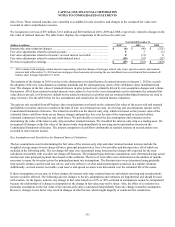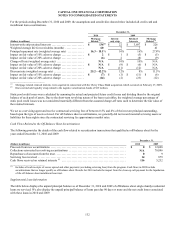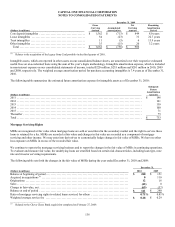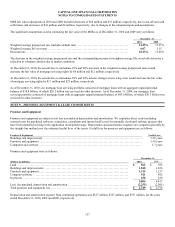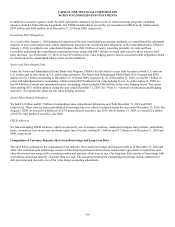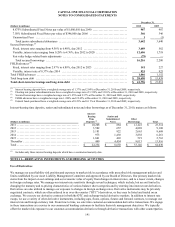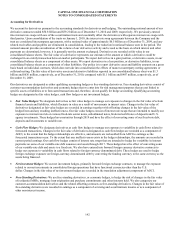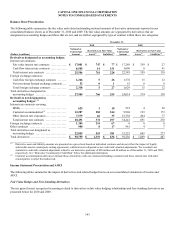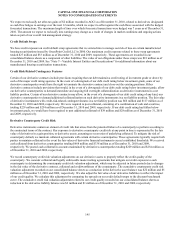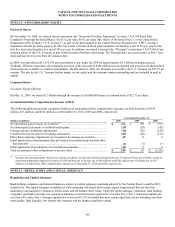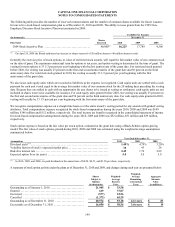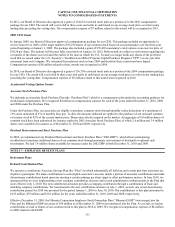Capital One 2010 Annual Report Download - page 161
Download and view the complete annual report
Please find page 161 of the 2010 Capital One annual report below. You can navigate through the pages in the report by either clicking on the pages listed below, or by using the keyword search tool below to find specific information within the annual report.
CAPITAL ONE FINANCIAL CORPORATION
NOTES TO CONSOLIDATED STATEMENTS
141
December 31,
(Dollars in millions) 2010 2009
8.875% Subordinated Fixed Notes par value of $1,000,010 due 2040 ............................ 987 987
7.50% Subordinated Fixed Notes par value of $346,000 due 2066 .............................. 346 346
Unamortized Fees .......................................................................... 1 (1)
Total junior subordinated debentures ....................................................... 3,642 3,640
Secured borrowings (3)
Fixed, interest rates ranging from 4.56% to 6.40%, due 2012 ................................... 3,689 562
Variable, interest rates ranging from 0.28% to 4.76%, due 2012 to 2028 ......................... 12,606 1,718
Fair value hedge-related basis adjustments .................................................... (79)
—
Total secured borrowings .................................................................. 16,216 2,280
FHLB advances (4)
Fixed, interest rates ranging from 2.97% to 6.88%, due 2012 to 2023 ........................... 141 227
Variable, interest rate of 0.37% due 2014 ..................................................... 925 925
Total FHLB advances ......................................................................... 1,066 1,152
Total long-term debt .......................................................................... $ 28,690 $ 15,438
Total short-term borrowings and long-term debt ............................................. $ 41,796 $ 21,014
________________________
(1) Interest bearing deposits have a weighted average rate of 1.37% and 2.04% at December 31, 2010 and 2009, respectively.
(2) Floating rate junior subordinated notes have a weighted average rate of 3.339% and 3.301% at December 31, 2010 and 2009, respectively.
(3) Secured borrowings have a weighted average rate of 1.85% and 2.37% at December 31, 2010 and 2009, respectively.
(4) FHLB advances have a weighted average rate 1.249% and 2.245% at December 31, 2010 and 2009, respectively.
(5) Federal funds purchased have a weighted average rate of 0.23% and 0.11% at December 31, 2010 and 2009, respectively.
Interest-bearing time deposits, senior and subordinated notes and other borrowings as of December 31, 2010, mature as follows:
(Dollars in millions)
Interest-
Bearing
Time
Deposits (1)
Senior and
Subordinated
Notes Other
Borrowings Total
2011 .................................................
.
$ 10,208 $ 884 $ 12,222 $ 23,314
2012 .................................................
.
3,582 657 4,869 9,108
2013 .................................................
.
5,181 822 2,665 8,668
2014 .................................................
.
973 1,430 3,858 6,261
2015 .................................................
.
1,841 403 519 2,763
Thereafter ............................................
.
449 4,454 9,013 13,916
Total .................................................
.
$ 22,234 $ 8,650 $ 33,146 $ 64,030
________________________
(1) Includes only those interest bearing deposits which have a contractual maturity date.
NOTE 11—DERIVATIVE INSTRUMENTS AND HEDGING ACTIVITIES
Use of Derivatives
We manage our asset/liability risk position and exposure to market risk in accordance with prescribed risk management policies and
limits established by our Asset Liability Management Committee and approved by our Board of Directors. Our primary market risk
stems from the impact on our earnings and our economic value of equity from changes in interest rates, and to a lesser extent, changes
in foreign exchange rates. We manage our interest rate sensitivity through several techniques, which include, but are not limited to,
changing the maturity and re-pricing characteristics of various balance sheet categories and by entering into interest rate derivatives.
Derivatives are also utilized to manage our exposure to changes in foreign exchange rates. Derivative instruments may be privately
negotiated contracts, which are often referred to as over-the-counter (“OTC”) derivatives, or they may be listed and traded on an
exchange. We execute our derivative contracts in both the OTC and exchange-traded derivative markets. In addition to interest rate
swaps, we use a variety of other derivative instruments, including caps, floors, options, futures and forward contracts, to manage our
interest rate and foreign currency risk. From time to time, we enter into customer-accommodation derivative transactions. We engage
in these transactions as a service to our commercial banking customers to facilitate their risk management objectives. We typically
offset the market risk exposure to our customer-accommodation derivatives through derivative transactions with other counterparties.


